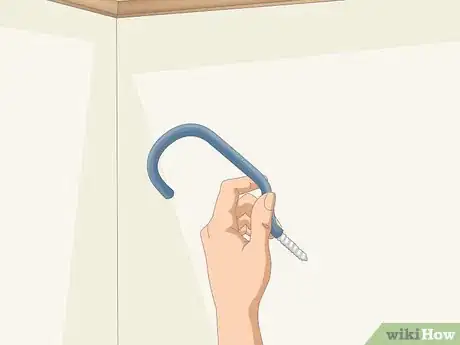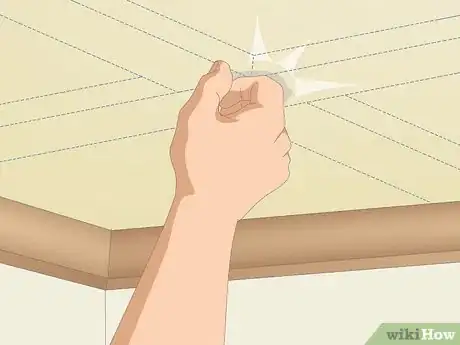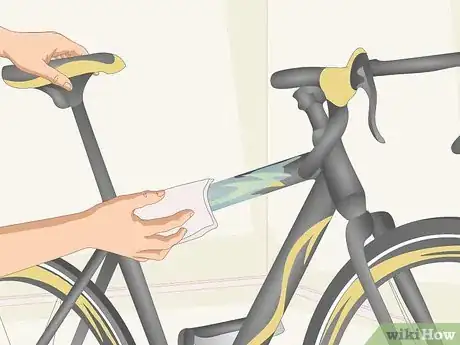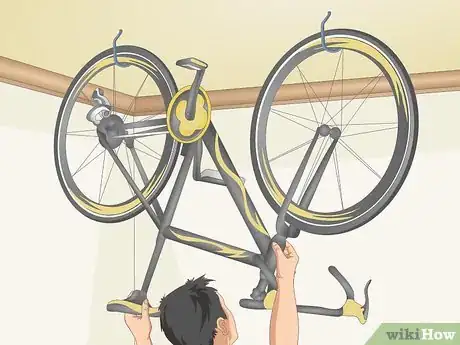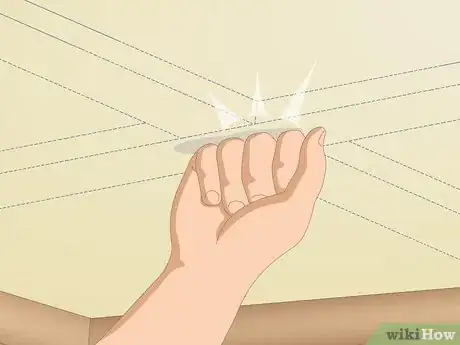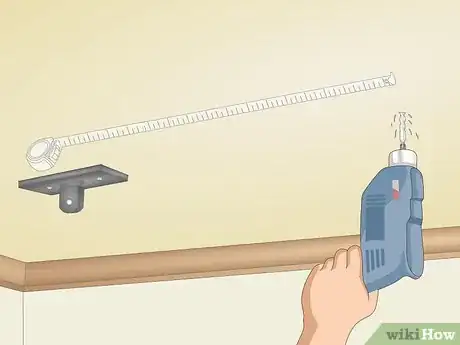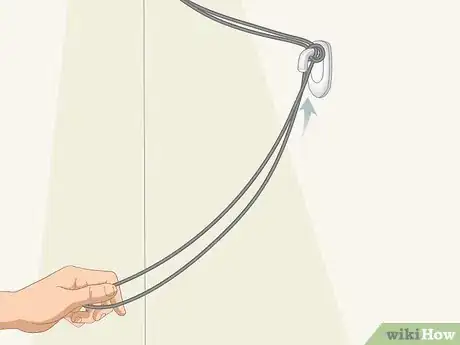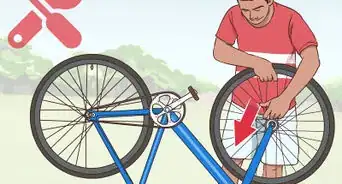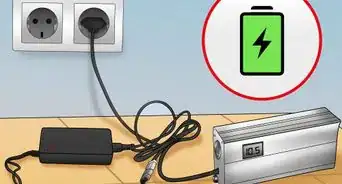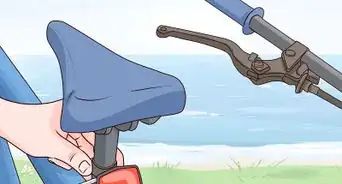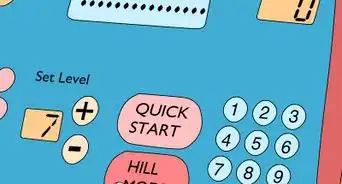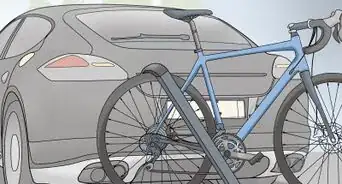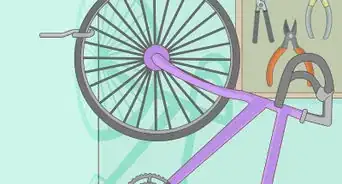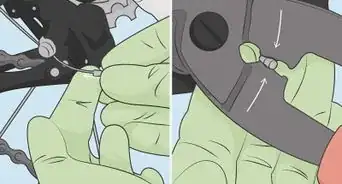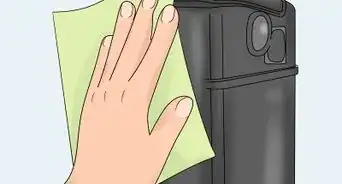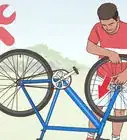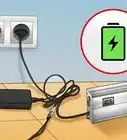This article was co-authored by Jason Phillip and by wikiHow staff writer, Janice Tieperman. Jason Phillip is a handyman specializing in mounting and hanging objects onto walls. With over five years of experience professionally mounting and installing objects through his company, Jason's Handyman Services, Jason's work includes working with mounting window AC units, designing art gallery walls, installing kitchen cabinets, and replacing light fixtures on drywall, brick, and plaster. He has been rated a "Top Pro" every year since 2016 by Thumbtack for being one of the highest-rated, most popular professionals on Thumbtack.
There are 23 references cited in this article, which can be found at the bottom of the page.
This article has been viewed 47,726 times.
While bikes are convenient and useful ways to get exercise, they aren’t as practical when the weather gets cold and icy. Instead of having your bike take up space in your home, consider hanging it from the ceiling of your garage, attic, basement, or other storage area! If you’re looking for a simple way to hang up your bikes, try attaching a rubber hook to a ceiling joist and dangling your equipment by one wheel. If you’re looking for a more convenient way to lift and lower your bikes, try using a pulley system instead!
Steps
Storing Bikes on Rubber Hooks
-
1Select a rubber or other non-metal hook to hold your bikes. Check your local hardware store or sporting goods shop to find a rubber hook, or a hook that isn’t made of bare metal. Look for a piece of equipment that’s about 0.3 in (0.76 cm) thick, so you can hang it in your storage area without it taking up too much space.[1]
- Don’t use metal hooks for long-term storage, as these can scrape and damage the wheels of your bike.
- Make sure the hooks you use are rated to support the weight of your bike so you don't damage your ceiling.[2]
-
2Find a section of your ceiling that won’t interfere with your vehicles. Search in your cellar, attic, garage or other storage area for a place where your bikes can stay for a long period of time. Depending on the height of your ceiling, you might not want to keep your bike in the center of your storage space.[3]
- If you aren’t sure whether or not your bike will be able to fit safely to your garage ceiling, take a quick measurement of your ceiling, vehicle, and bike’s height to make sure.
Advertisement -
3Tap the ceiling with your hand to find the ceiling joists. Set up a ladder to reach the ceiling. If the surface is covered in drywall, tap around the ceiling to find a solid area. Once you’ve found a solid spot, mark it with a pencil or some other writing tool.[4]
- Hollow areas will sound echoey when you tap on them, while solid areas will sound firm.
- If your ceiling has beams instead of drywall, you don’t have to worry about this.
- If you’re having difficulty finding the ceiling joists, you can also use a stud finder.
-
4Measure the hook’s diameter to choose a proper drill bit. Examine the rubber hook that you’re planning to hang from your ceiling. Measure the diameter of the screw, then select an electric drill bit that’s about ⅔ of the screw’s width. Always use a drill bit that’s smaller in diameter than the hook that you’re using. When the bit is slightly smaller, you can firmly and securely install the hook into the ceiling.[5]
- If your drill bit is too large, your hook might be too loose.
-
5Create a pilot hole in the ceiling with an electric drill. Take your chosen bit and twist it into your drill. With a small amount of force, guide the drill into a solid section of beam. Use the entire length of the bit to create your pilot hole, then remove the device.[6]
-
6Screw your ceiling hook into the drilled pilot hole. Use your hands to push and twist the ceiling hook into the pilot hole. Turn the hook clockwise to secure it into the ceiling. If you’re having trouble tightening the hook, stick a screwdriver horizontally through the curved portion of the hook and twist it like a vice.[7]
- Continue twisting until the hook is secure, and no longer shifts or turns.
-
7Install a second hook if you want to hang your bike by 2 wheels. Measure the distance between the center axles of your bike wheels. Once your first hook is in place, use a tape measure to mark off that same distance from the initial hook. Drill a guiding hole through this mark, then twist a second bike hook into place.[8]
- If you’re planning on hanging up several bikes, use this measuring system to install multiple hooks.
-
8Wipe down your bike with a wet paper towel. Take a damp paper towel or disinfectant wipe and clean off any visible dust, sweat or grime from your bike. Try and clean off all sections of the bike, as you don’t want any dust or debris falling and clogging up the chains and gears of your bike while it's in storage.[9]
- Sweat can be commonly found on most bikes, especially if you use your equipment a lot. Try to wipe away sweat as soon as you see it, or it could drip further into your bike.
-
9Lift your bicycle and mount the wheel on the hook. Hold your bike from the center tube and bring it to the ceiling. Rotate your bike slowly, lifting the metal rim of the back wheel over the curve of the hook. Remove 1 hand at a time to make sure that your bike is secure.[10]
- There’s nothing wrong with placing your equipment in an upside-down or perpendicular position.
-
10Mount both wheels if you have 2 hooks. Hold your bike from the center tube and lift it upwards. Rotate the equipment by 180 degrees, bringing both wheels up to the hooks. Place 1 wheel onto a ceiling hook at a time, making sure that the metal rim is resting over the rubber hook. Remove your hands gradually to make sure that the bike is in place.[11]
Using a Pulley System
-
1Acquire a pulley kit from your local hardware store. Before you begin any construction in your storage area, head to a hardware store or sporting goods shop to purchase a “bike pulley” or “bike hoist” kit. These kits generally include 2 pulley brackets, 2 hooks, a length of cord, and the screws needed for installation. You can save a lot of time by purchasing these supplies in a bundle, instead of searching for each part individually.[12]
- You can get a pulley kit for as low as $9.
-
2Tap the ceiling to locate the ceiling joists. Form a fist and knock on the ceiling of your storage area. Depending on the place you’re storing your bikes, you might see visible beams and joists that you can use for your pulley system. If your ceiling is obscured or otherwise covered, tap on a specific area and listen for a firm or echoing sound. If the resonating sound is firm, then you’ve found a joist.[13]
- Try measuring 16 in (41 cm) to find another ceiling joist, just to make sure.[14]
-
3Screw 1 pulley bracket into a ceiling joist with an electric drill. Arrange your metal bracket along the length of the joist where you’d like your bike to hang. Don’t worry about the exact measurements of your bike at this point. Instead, use your hand to hold the pulley in place, and use an electric drill to secure 4 screws into the corresponding bracket holes.[15]
- Depending on your storage space, you might have difficulty attaching the screws in the joist right off the bat. In this case, use your drill bit to form as many pilot holes as there are openings in the bracket. This will make it easier for you to add screws later on.
- You’ll need bike measurements when attaching the second pulley bracket.
-
4Measure the width of your bike seat to the handlebars. Take a measuring tape and extend it from the back of your bike seat to the center of your handlebars. Write down this measurement or commit it to memory, as it will help you arrange and attach your second pulley bracket.[16]
- The pulley system hooks along the back edge of your bike seat and the front your handlebars.
-
5Drill a pilot hole using the measurements from your bike. Use your measuring tape to determine your bike’s length in relation to the first pulley. Arrange the pulley bracket along the same ceiling joist, centering it over the end of your bike measurement. Hold the bracket in place with your hand, using your electric drill to create pilot holes through the openings of the bracket.[17]
- This process is the same as when you attached the first pulley bracket.
-
6Thread and knot the pulley cord through the second bracket. Pull a section of your pulley cord through the back opening of your bracket. Use a firm knot to keep the cord in place, so the pulley system is secure. Once you’ve knotted the rope, let the rest of the cord dangle.[18]
- Figure-eight knots are good for this kind of project.
- The hole for the pulley cord is separate from the openings for the screws. Look for the end of the pulley that has an extra opening to figure out where the cord goes.
-
7Attach the second pulley bracket using the pilot holes. With the cord looped through the back, arrange the metal bracket over the pilot holes that you drilled previously. Use an electric drill to attach screws through these openings. Continue applying pressure until the bracket is firmly secured to the ceiling.[19]
- Don’t attach any screws over the cord.
-
8Loop the cord through both pulley brackets and hooks. Slide the hook apparatus onto the length of cord that you’re threading through the pulley system. Take the loose end of this cord and bring it up and over the circular wheel of the pulley. Next, drag the length of cord horizontally so it attaches to the second pulley. Slide the second hook onto the cord, then loop the end of the rope up and over the circular wheel of this pulley bracket.[20]
-
9Attach a heavy-duty adhesive hook to the wall. Pull off the backing paper from 1 side of the adhesive strip, then firmly press the sticky side of the strip to the wall. Next, remove the other section of backing paper from the adhesive. Take the back of the hook structure and press it firmly onto the sticky strip for several seconds to successfully set it up.[21]
- Try choosing an adhesive hook with “utility” or “heavy-duty” on the label. While your pulley cord won’t be that heavy, you don’t want to use a flimsy hook.
- Always follow the instructions on the hook’s packaging.
-
10Tie any extra cord to the hook on the lower wall. Leave 1 to 2 yards (0.91 to 1.83 m) of cord dangling from the pulley, so you can securely lift and lower your bike from your storage area. Loop the extra cord around the wall hook, so you can unspool it whenever you need to access your bike. If you don’t leave enough slack for your pulley system, your bike hoist might not function properly.[22]
- If you have more than 1 pulley system hooked up in your storage area, be sure to have separate wall hooks to prevent the cords from tangling.
-
11Secure the hooks to the handlebars and bike seat. Take 1 hook and attach it beneath the back of your bike seat. Next, take the second hook and arrange it beneath the piping of your handlebars. Before you do anything else, check that these hooks are secure, and that they aren’t going to shift and separate from the bike.[23]
- Ideally, your hooks should have a rubber seal. If your hooks are only made of metal, then they might scratch your handlebars.
-
12Pull on the cord to lift up the bike. Tug your cord at a 45-degree angle so the safety brake on your pulley system is released. Continue pulling on the cord to raise the bike until it reaches the ceiling of your storage area. Once you’ve lifted the bike, release the cord and loop it around the designated wall hook.[24]
Did you know? You can lower the bikes by pulling the cord at a 45-degree angle and releasing the slack.[25]
Expert Q&A
Did you know you can get expert answers for this article?
Unlock expert answers by supporting wikiHow
-
QuestionHow do I securely hang something from the ceiling?
 Jason PhillipJason Phillip is a handyman specializing in mounting and hanging objects onto walls. With over five years of experience professionally mounting and installing objects through his company, Jason's Handyman Services, Jason's work includes working with mounting window AC units, designing art gallery walls, installing kitchen cabinets, and replacing light fixtures on drywall, brick, and plaster. He has been rated a "Top Pro" every year since 2016 by Thumbtack for being one of the highest-rated, most popular professionals on Thumbtack.
Jason PhillipJason Phillip is a handyman specializing in mounting and hanging objects onto walls. With over five years of experience professionally mounting and installing objects through his company, Jason's Handyman Services, Jason's work includes working with mounting window AC units, designing art gallery walls, installing kitchen cabinets, and replacing light fixtures on drywall, brick, and plaster. He has been rated a "Top Pro" every year since 2016 by Thumbtack for being one of the highest-rated, most popular professionals on Thumbtack.
Handyman
Things You’ll Need
Storing Bikes on Rubber Hooks
- Rubber hooks
- Electric drill
- Drill bit
- Screwdriver (optional)
- Paper towel or wipe
Using a Pulley System
- Pulley brackets
- Stud finder (optional)
- Measuring tape
- Screws
- Electric drill
- Pulley cord
- Pulley hooks
- Wall hooks
References
- ↑ https://m.youtube.com/watch?v=0Rp-T1Niftg&t=0m10s
- ↑ Jason Phillip. Handyman. Expert Interview. 2 July 2020.
- ↑ https://www.roadbikerider.com/bicycle-storage-with-bike-hooks-d3/
- ↑ https://m.youtube.com/watch?v=kF32I8gENl4&t=0m47s
- ↑ https://m.youtube.com/watch?v=0Rp-T1Niftg&t=0m28s
- ↑ https://m.youtube.com/watch?v=kF32I8gENl4&t=1m2s
- ↑ https://m.youtube.com/watch?v=gv2ZVNpiJGU&t=0m28s
- ↑ https://m.youtube.com/watch?v=EeDrXaUbSuU&t=0m29s
- ↑ https://www.roadbikerider.com/bicycle-storage-with-bike-hooks-d3/
- ↑ https://m.youtube.com/watch?v=0Rp-T1Niftg&t=1m56s
- ↑ https://m.youtube.com/watch?v=gv2ZVNpiJGU&t=0m7s
- ↑ https://m.youtube.com/watch?v=fNI8_qjDewM&t=4m54s
- ↑ https://m.youtube.com/watch?v=kF32I8gENl4&t=0m46s
- ↑ https://m.youtube.com/watch?v=kF32I8gENl4&t=1m13s
- ↑ https://m.youtube.com/watch?v=kF32I8gENl4&t=1m31s
- ↑ https://m.youtube.com/watch?v=kF32I8gENl4&t=2m19s
- ↑ https://m.youtube.com/watch?v=kF32I8gENl4&t=2m31s
- ↑ https://m.youtube.com/watch?v=kF32I8gENl4&t=2m53s
- ↑ https://m.youtube.com/watch?v=kF32I8gENl4&t=3m5s
- ↑ https://m.youtube.com/watch?v=2qlK88gx9GU&t=3m12s
- ↑ https://m.youtube.com/watch?v=PuaECYj84FA&t=0m13s
- ↑ https://m.youtube.com/watch?v=kF32I8gENl4&t=4m51s
- ↑ https://m.youtube.com/watch?v=fNI8_qjDewM&t=4m54s
- ↑ https://m.youtube.com/watch?v=fNI8_qjDewM&t=6m11s
- ↑ https://m.youtube.com/watch?v=fNI8_qjDewM&t=6m8s
